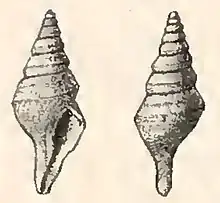| Optoturris optatus Temporal range: Late Oligocene - Late Miocene | |
|---|---|
 | |
| Shell of Optoturris optatus (holotype) | |
| Scientific classification | |
| Domain: | Eukaryota |
| Kingdom: | Animalia |
| Phylum: | Mollusca |
| Class: | Gastropoda |
| Subclass: | Caenogastropoda |
| Order: | Neogastropoda |
| Superfamily: | Conoidea |
| Family: | Turridae |
| Genus: | †Optoturris |
| Species: | †O. optatus |
| Binomial name | |
| †Optoturris optatus (G.F. Harris, 1897) | |
| Synonyms | |
|
Pleurotoma optata G.F. Harris, 1897 | |
Optoturris optatus is an extinct species of sea snail, a marine gastropod mollusk in the family Turridae, the turrids.[1]
Description
The length of the shell attains 16.5 mm; the maximum diameter is 6 mm; length of the aperture: 9.5 mm.
(Original description) The shell has a fusiform shape. The aperture (with siphonal canal) measures more than ½ the length of the whole shell. The shell contains seven whorls, slightly convex, keeled above and below the suture, which is near the centre of the whorls, the anterior keel being the most prominent. The other ornament consists of several closely-set small spiral lineations, crossed by rather conspicuous growth lines, and accompanied by a peculiar damascened structure. The protoconch is composed of two smooth whorls, the anterior being subangulate and vertically striated It terminates abruptly against the shell of the brephic stage, which is longitudinally, obliquely costated and marginate. The aperture is elongately pyriform, much constricted anteriorly. The outer lip is thin and undulating. The sinus is broad and shallow. The columella is covered by a thin deposit of vertically striated callus and is twisted anteriorly. The siphonal canal is long, curved and broad in front.[2]
Distribution
Fossils of this marine species were found in Miocene strata in Victoria, Australia.
References
- ↑ A.W.B. Powell, The Australian Tertiary Mollusca of the Family Turridae; Records of the Auckland Institute and Museum, Vol. 3, No. 1 (1944)
- ↑ Harris G.F. (1897) Catalogue of Tertiary Molluscs in the British Museum of Natural History